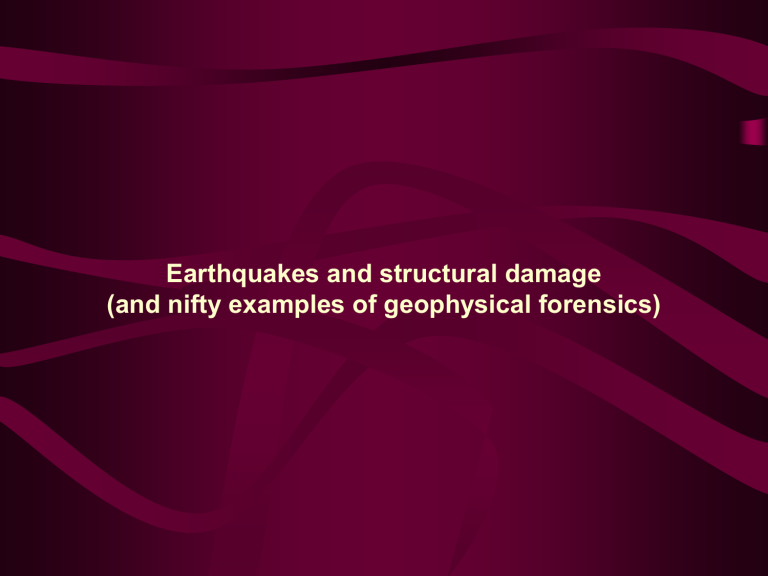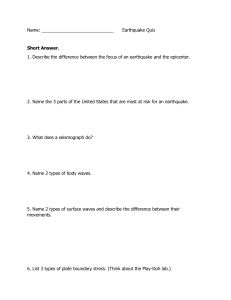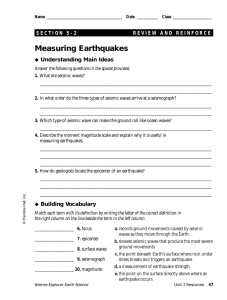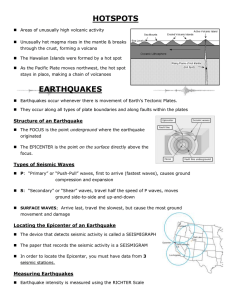
Earthquakes and structural damage (and nifty examples of geophysical forensics) What is an earthquake ? • An earthquake is the vibration of Earth produced by the rapid release of energy • Energy released radiates in all directions from its source, the focus • Energy is in the form of waves • Sensitive instruments around the world record the event Earthquake focus and epicenter What is an earthquake • Earthquakes and faults • Movements that produce earthquakes are usually associated with large fractures in Earth’s crust called faults • Most of the motion along faults can be explained by the plate tectonics theory What is an earthquake • Elastic rebound • Mechanism for earthquakes was first explained by H.F. Reid – Rocks on both sides of an existing fault are deformed by tectonic forces – Rocks bend and store elastic energy – Frictional resistance holding the rocks together is overcome What is an earthquake ? • Elastic rebound • Earthquake mechanism – Slippage at the weakest point (the focus) occurs – Vibrations (earthquakes) occur as the deformed rock “springs back” to its original shape (elastic rebound) • Earthquakes most often occur along existing faults whenever the frictional forces on the fault surfaces are overcome San Andreas: An active earthquake zone • San Andreas is the most studied fault system in the world • Displacement occurs along discrete segments 100 to 200 kilometres long • Some portions exhibit slow, gradual displacement known as fault creep • Other segments regularly slip producing small earthquakes San Andreas: An active earthquake zone • Displacements along the San Andreas fault • Still other segments store elastic energy for hundreds of years before rupturing in great earthquakes – Process described as stick-slip motion – Great earthquakes should occur about every 50 to 200 years along these sections Displacement produced during the 1906 San Francisco earthquake Seismology • Seismographs are instruments that record seismic waves • Records the movement of Earth in relation to a stationary mass on a rotating drum or magnetic tape A seismograph designed to record vertical ground motion Seismology • Seismographs • More than one type of seismograph is needed to record both vertical and horizontal ground motion • Types of seismic waves • Surface waves • Body waves Seismology • Types of seismic waves • Surface waves – Travel along outer part of Earth – Complex motion – Cause greatest destruction – referred to as long waves, or L waves Seismology • Types of seismic waves • Body Waves (Primary and Secondary) – Primary (P) waves » Push-pull (compress and expand) motion, changing the volume of the intervening material » Travel through solids, liquids, and gases – Secondary (S) waves » Shake" motion at right angles to their direction of travel » Travel only through solids Seismology • Types of seismic waves • Body waves – Secondary (S) waves » Slower velocity than P waves » Slightly greater amplitude than P waves Locating the source of earthquakes • Terms • Focus - the place within Earth where earthquake waves originate • Epicenter – location on the surface directly above the focus • Epicenter is located using the difference in velocities of P and S waves Locating the source of earthquakes • Locating the epicenter of an earthquake • Three station recordings are needed to locate an epicenter • Each station determines the time interval between the arrival of the first P wave and the first S wave at their location • A travel-time graph is used to determine each station’s distance to the epicenter A time-travel graph is used to find the distance to the epicentre Locating the source of earthquakes • Locating the epicenter of an earthquake • A circle with a radius equal to the distance to the epicenter is drawn around each station • The point where all three circles intersect is the earthquake epicenter The epicenter is located using three or more seismograph Locating the source of earthquakes • Earthquake belts • About 95 percent of the energy released by earthquakes originates in a few relatively narrow zones that wind around the globe • Major earthquake zones include the Circum-Pacific belt, Mediterranean Sea region to the Himalayan complex, and the oceanic ridge system Distribution of magnitude 5 or greater earthquakes, 1980 - 1990 Locating the source of earthquakes • Earthquake depths • Definite patterns exist – Shallow focus occur along the oceanic ridge system – Almost all deep-focus earthquakes occur in the circum-Pacific belt, particularly in regions situated landward of deep-ocean trenches Relationship of earthquake depth to subduction zones Measuring the size of earthquakes • Two measurements that describe the size of an earthquake are • Intensity – a measure of the degree of earthquake shaking at a given locale based on the amount of damage • Magnitude – estimates the amount of energy released at the source of the earthquake Measuring the size of earthquakes • Magnitude scales • Richter magnitude - concept introduced by Charles Richter in 1935 • Richter scale – Based on the amplitude of the largest seismic wave recorded – Accounts for the decrease in wave amplitude with increased distance Measuring the size of earthquakes • Magnitude scales • Richter scale – Largest magnitude recorded on a WoodAnderson seismograph was 8.9 (earthquake in Chile, 1960 – – Magnitudes less than 2.0 are not felt by humans – Each unit of Richter magnitude increase corresponds to a tenfold increase in wave amplitude and a 32-fold energy increase Earthquake destruction • Amount of structural damage attributable to earthquake vibrations depends on • Intensity and duration of the vibrations • Nature of the material upon which the structure rests • Design of the structure Earthquake destruction • Destruction from seismic vibrations • Ground shaking – Regions within 20 to 50 kilometers of the epicenter will experience about the same intensity of ground shaking – However, destruction varies considerably mainly due to the nature of the ground on which the structures are built Damage caused by the 1964 Anchorage, Alaska earthquake Earthquake destruction • Destruction from seismic vibrations • Basic Shaking -degree of damage partly depends on severity of earthquake and integrity of material (e.g. buildings on igneous rocks sustain less damage than on loose sediments) Earthquake destruction • Liquefaction of the ground – Unconsolidated materials saturated with water turn into a mobile fluid – Characterization of material upon which buildings are constructed can make or break an insurance claim (Damage due to earthquake-induced liquefaction, or faulty construction ? Differences in effect can be more subtle than one might think). - relevant also to building contractors (can be sued for knowingly building on high-risk ground) Effects of liquefaction Buildings built on poorly consolidated sediment -tilted due to sediment liquefaction resulting from earthquake An accident long-waiting to happen Subdivision at Point Fermin, California -shore undercut by waves, poorly consolidated material highly unstable -add seismic activity, and you’re toast ! Forensics on a Global Scale Seismographs not only tell us when and where an earthquake occurred. Other vibrations can also be recorded: Rockfalls (if close enough to recording station), Mine and Quarry Blasts, Nuclear Explosions Geophysicists can use seismograph records to subtantiate or dispel reported events that could produce significant vibrations Similar to the way voices of different people differ in acoustic characteristics, so do different seismic events (seismic fingerprints). For example, nuclear test events can be detected Significant nuclear test sites: 1945-1998 Comparison of signatures of nuclear test explosion and an earthquake Primary Secondary Surface Waves Nuclear test recorded at international monitoring station in Pakistan, May 11, 1998, about 740 km from blast Example: Alleged nuclear testing in Iraq in 1989 Alleged test was reported to have been carried in the vicinity of Lake Rezazza, approximately 100 km southwest of Baghdad at 10:30 am on 19 September, 1989 Terry Wallace (University of Arizona), examined the global seismicity catalogues produced by the International Seismic Center and the US Geological Survey. No seismic disturbances at all were detected in Iraq that day Significantly, no seismicity within 50 km of the reported test site was apparent for the years 1980 to 1999 ! Problem: some asserted that the lower limit of detection for global catalogues was magnitude 4.0, so it was possible that a smaller magnitude event might have not been picked up by the sensors. However, seismicity catalogues for Israel, Jordan and Iran (well within range of detection) reported no seismic event in the region on that date either (19 September 1989). Verdict: allegation of Iraqi nuclear testing was false Another Example: Sinking of Russian Sub 12th August 2000, it was reported that a Russian submarine (the Kursk) sank north of Kola Peninsula (Barents Sea). On same date, two explosions were detected on seismic records, with gap of two minutes between explosions (the second event being much bigger) Comparison of results from different seismograph revealed that the second explosion was the equivalent of five tonnes of TNT exploding (within the range expected for detonation of a nuclear warhead) Other events detected from seismograph records 1. Sinking of USS Scorpion submarine near the mid-Atlantic ridge in 1968 2. Sinking of another Russian sub in the Baltic in 1989. 3. Sinking of a large oil derrick in the North Sea (produced a 3.5-magnitude quake when it hit the ocean floor) END OF LECTURE








